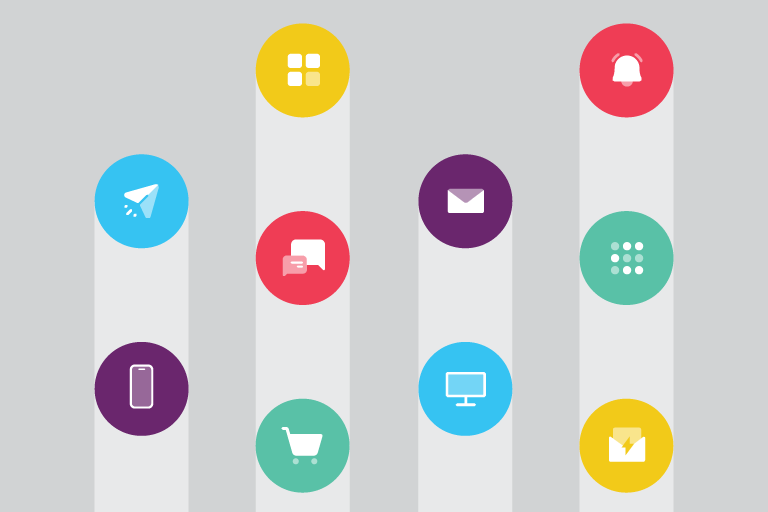As fall enthusiasts celebrate the return of the pumpkin spice latte (PSL), brand marketers are busy bracing themselves for another holiday marketing season. To ensure your upcoming promotions are firing on all cylinders, it’s critical to design the best cross-channel customer experience possible.
The good news is you’ve come to the right place. Iterable has a blog full of cross-channel customer experience best practices, but we get it if you’re strapped for time and can’t read through our entire archive.
That’s why, in this post, we’ve summarized our top seven tips. Here’s how to create an exceptional cross-channel experience and build lasting brand loyalty.
1. Consolidate Your Martech Stack
Like a closet bursting at the seams, having hundreds of marketing solutions is a waste that clutters your life and drains your dollars. On the other hand, consolidating your martech stack is like curating an elegant capsule wardrobe. Consolidation is crucial to reducing redundancies, increasing ROI, and scaling the impact of your team.
We break down the details of conducting a martech stack audit, but the first step is to take inventory of all the platforms you have and align them to the use cases they support. Once you identify any glaring overlap, you can set out to remove any unnecessary tools.
2. Reevaluate How Your Customer Data is Managed
The foundation of any martech stack architecture is the data layer—meaning how customer data is collected, stored, accessed, and activated. The issue for most companies is sitting on a wealth of information but not knowing how to put it to good use. This is what we refer to as the Activation Gap, and it leads to poor customer experiences.
Following the previous tip and eliminating redundancy will streamline the flow of data, but it’s important to dig deeper and implement a modern customer data management strategy. It can be challenging to weigh the benefits of a cloud data warehouse, a reverse ETL solution, or CDP, but with Iterable’s partner ecosystem, we can help you find the right technology for your business.
3. Automate the Entire Customer Journey
An ideal cross-channel customer experience involves sending relevant messages through the right communication channels at the perfect moment. But this isn’t possible if you haven’t determined what these crucial channels, messages, and moments are. After all, you can’t automate what you haven’t outlined, so it’s key to plot the full customer journey, from initial awareness all the way through to first purchase and long-term loyalty.
Lifecycle mapping and customer journey automation go hand in hand, so to make things simple, we have a personalization playbook that walks you through the four key steps to creating the ideal customer journey: defining your customer, identifying the problems they face, positioning your brand as the solution, and calling the customer to action.
4. Prioritize a Mobile Cross-Channel Customer Experience
The mobile experience is like an umbrella containing multiple communication channels, so connecting them seamlessly is crucial: SMS, push notifications, in-app messages, and the mobile inbox. This also involves optimizing email and browser notifications for mobile devices and even adding QR codes to direct mail or in-store promotions.
Improving your company’s mobile experience means fostering conversations with customers that are immediate, informative, intimate, and individual. Going mobile-first doesn’t necessarily mean building an app from scratch—although if your brand already has one, we have plenty of tips to successfully grow your app user base. There are countless ways to increase mobile engagement, including adding embedded messages to a mobile-optimized website, setting up smart opt-in permissions, deploying actionable push notifications, and enhancing your SMS/MMS strategy. Start by executing the tactics that will make the biggest impact on your users.
5. Train Your Teams on AI Marketing
There are a ton of misconceptions and myths around AI marketing, but true innovation isn’t achieved without experimentation. Before the summer ends, brush up on the basics by studying the five 5Ws of AI marketing and start creating your own repository of great examples of AI-powered campaigns across all your channels.
Once everyone on your team has a better understanding of what’s possible with AI, they can brainstorm how to apply it to develop more creative messaging for your brand, whether it’s copy generation for subject lines or automatic decision-making on when to send an email or text.
6. Put Your Sends on Autopilot
Cross-channel marketing has moved way beyond sending a message at 9 a.m. on a Tuesday. If you’re going to orchestrate a breadth of channels—like email, SMS, mobile push, web push, direct mail, connected TV, and more—the last thing you need is to manually determine when, where, and how often to communicate with customers.
Thankfully, with Iterable’s AI optimization of send time, channel, and frequency, you can let AI decide based on the historical engagement data of each individual user.
7. Continue to Test and Experiment
As our name suggests, we’re big fans of iteration. It’s not recommended to just set-it-and-forget-it when it comes to cross-channel marketing—customer behavior is always in flux. After implementing the previous tips, carve out time for testing, whether it’s running an A/B split on a holiday promo or trying out a new email design. Don’t let your customer experience go stale, especially in the lead-up to the biggest shopping season where standing out among your competitors is mission-critical.
This list of cross-channel customer experience tips could be a mile long, but the very best tip we can share is just to get started. Grab that seasonal caffeinated drink of your choice, and charge ahead on bringing a joyous experience to your customers, wherever they are.
Want our personalized recommendations on how to design the best cross-channel customer experience for your business? Reach out to schedule a custom demo of Iterable’s all-in-one customer communication platform today.

































